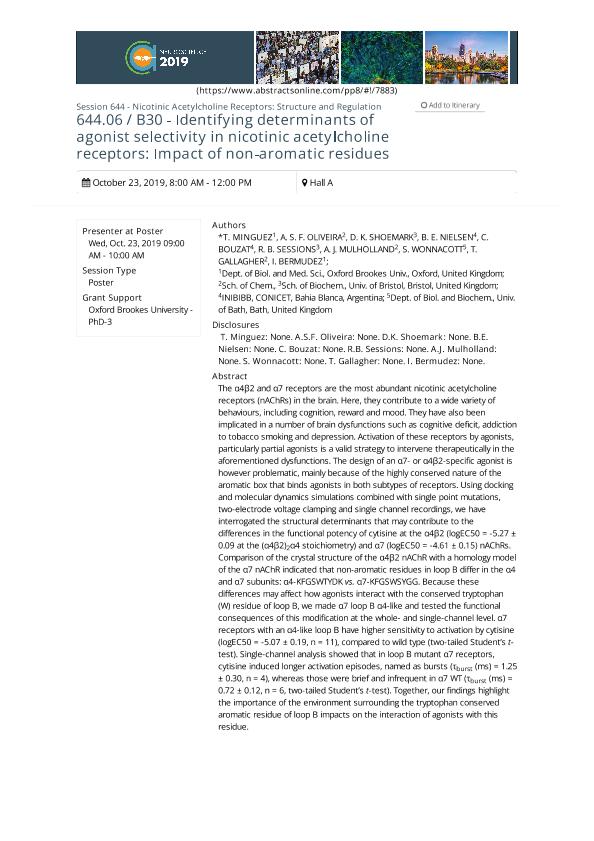Mostrar el registro sencillo del ítem
dc.contributor.author
Minguez, Teresa
dc.contributor.author
Oliveria, Sofia
dc.contributor.author
Shoemark, D. K.
dc.contributor.author
Nielsen, Beatriz Elizabeth

dc.contributor.author
Bouzat, Cecilia Beatriz

dc.contributor.author
Sessions, R. B.
dc.contributor.author
Mullholand, Adrian
dc.contributor.author
Wonnacott, Susan
dc.contributor.author
Gallagher, Timothy
dc.contributor.author
Bermudez, Isabel
dc.date.available
2023-03-21T02:32:59Z
dc.date.issued
2019
dc.identifier.citation
Identifying determinants of agonist selectivity in nicotinic acetylcholine receptors: Impact of non-aromatic residues; Neuroscience Meeting 2019 of the Society for Neuroscience; Chicago; Estados Unidos; 2019; 1-1
dc.identifier.uri
http://hdl.handle.net/11336/191114
dc.description.abstract
The α4β2 and α7 receptors are the most abundant nicotinic acetylcholine receptors (nAChRs) in the brain. Here, they contribute to a wide variety of behaviours, including cognition, reward and mood. They have also been implicated in a number of brain dysfunctions such as cognitive deficit, addiction to tobacco smoking and depression. Activation of these receptors by agonists, particularly partial agonists is a valid strategy to intervene therapeutically in the aforementioned dysfunctions. The design of an α7- or α4β2-specific agonist is however problematic, mainly because of the highly conserved nature of the aromatic box that binds agonists in both subtypes of receptors. Using docking and molecular dynamics simulations combined with single point mutations, two-electrode voltage clamping and single channel recordings, we have interrogated the structural determinants that may contribute to the differences in the functional potency of cytisine at the α4β2 (logEC50 = -5.27 ± 0.09 at the (α4β2)2α4 stoichiometry) and α7 (logEC50 = -4.61 ± 0.15) nAChRs. Comparison of the crystal structure of the α4β2 nAChR with a homology model of the α7 nAChR indicated that non-aromatic residues in loop B differ in the α4 and α7 subunits: α4-KFGSWTYDK vs. α7-KFGSWSYGG. Because these differences may affect how agonists interact with the conserved tryptophan (W) residue of loop B, we made α7 loop B α4-like and tested the functional consequences of this modification at the whole- and single-channel level. α7 receptors with an α4-like loop B have higher sensitivity to activation by cytisine (logEC50 = -5.07 ± 0.19, n = 11), compared to wild type (two-tailed Student’s t-test). Single-channel analysis showed that in loop B mutant α7 receptors, cytisine induced longer activation episodes, named as bursts (τburst (ms) = 1.25 ± 0.30, n = 4), whereas those were brief and infrequent in α7 WT (τburst (ms) = 0.72 ± 0.12, n = 6, two-tailed Student’s t-test). Together, our findings highlight the importance of the environment surrounding the tryptophan conserved aromatic residue of loop B impacts on the interaction of agonists with this residue.
dc.format
application/pdf
dc.language.iso
eng
dc.publisher
Society for Neuroscience
dc.rights
info:eu-repo/semantics/openAccess
dc.rights.uri
https://creativecommons.org/licenses/by-nc-sa/2.5/ar/
dc.subject
NICOTINIC RECEPTORS
dc.subject
AGONIST SELECTIVITY
dc.subject.classification
Biofísica

dc.subject.classification
Ciencias Biológicas

dc.subject.classification
CIENCIAS NATURALES Y EXACTAS

dc.title
Identifying determinants of agonist selectivity in nicotinic acetylcholine receptors: Impact of non-aromatic residues
dc.type
info:eu-repo/semantics/publishedVersion
dc.type
info:eu-repo/semantics/conferenceObject
dc.type
info:ar-repo/semantics/documento de conferencia
dc.date.updated
2023-02-01T14:52:00Z
dc.journal.pagination
1-1
dc.journal.pais
Estados Unidos

dc.journal.ciudad
Chicago
dc.description.fil
Fil: Minguez, Teresa. Oxford Brookes University (oxford Brookes University);
dc.description.fil
Fil: Oliveria, Sofia. Oxford Brookes University (oxford Brookes University);
dc.description.fil
Fil: Shoemark, D. K.. Oxford Brookes University (oxford Brookes University);
dc.description.fil
Fil: Nielsen, Beatriz Elizabeth. Consejo Nacional de Investigaciones Científicas y Técnicas. Centro Científico Tecnológico Conicet - Bahía Blanca. Instituto de Investigaciones Bioquímicas de Bahía Blanca. Universidad Nacional del Sur. Instituto de Investigaciones Bioquímicas de Bahía Blanca; Argentina
dc.description.fil
Fil: Bouzat, Cecilia Beatriz. Consejo Nacional de Investigaciones Científicas y Técnicas. Centro Científico Tecnológico Conicet - Bahía Blanca. Instituto de Investigaciones Bioquímicas de Bahía Blanca. Universidad Nacional del Sur. Instituto de Investigaciones Bioquímicas de Bahía Blanca; Argentina
dc.description.fil
Fil: Sessions, R. B.. University of Bristol; Reino Unido
dc.description.fil
Fil: Mullholand, Adrian. University of Bristol; Reino Unido
dc.description.fil
Fil: Wonnacott, Susan. University of Bath; Reino Unido
dc.description.fil
Fil: Gallagher, Timothy. University of Bristol; Reino Unido
dc.description.fil
Fil: Bermudez, Isabel. Oxford Brookes University (oxford Brookes University);
dc.relation.alternativeid
info:eu-repo/semantics/altIdentifier/url/https://www.abstractsonline.com/pp8/#!/7883
dc.conicet.rol
Autor

dc.conicet.rol
Autor

dc.conicet.rol
Autor

dc.conicet.rol
Autor

dc.conicet.rol
Autor

dc.conicet.rol
Autor

dc.conicet.rol
Autor

dc.conicet.rol
Autor

dc.conicet.rol
Autor

dc.conicet.rol
Autor

dc.coverage
Internacional
dc.type.subtype
Congreso
dc.description.nombreEvento
Neuroscience Meeting 2019 of the Society for Neuroscience
dc.date.evento
2019-10-19
dc.description.ciudadEvento
Chicago
dc.description.paisEvento
Estados Unidos

dc.type.publicacion
Book
dc.description.institucionOrganizadora
Society for Neuroscience
dc.source.libro
2019 Neuroscience Meeting Planner
dc.date.eventoHasta
2019-10-23
dc.type
Congreso
Archivos asociados
